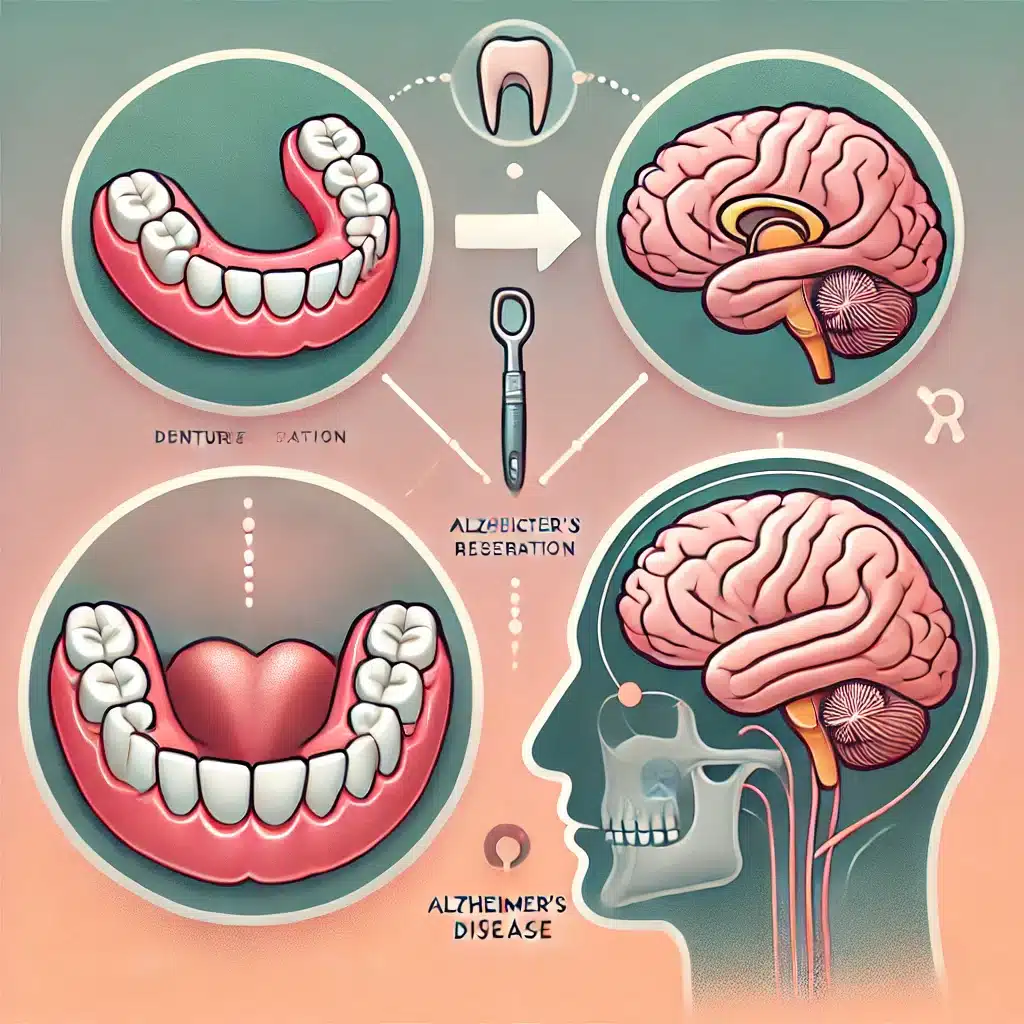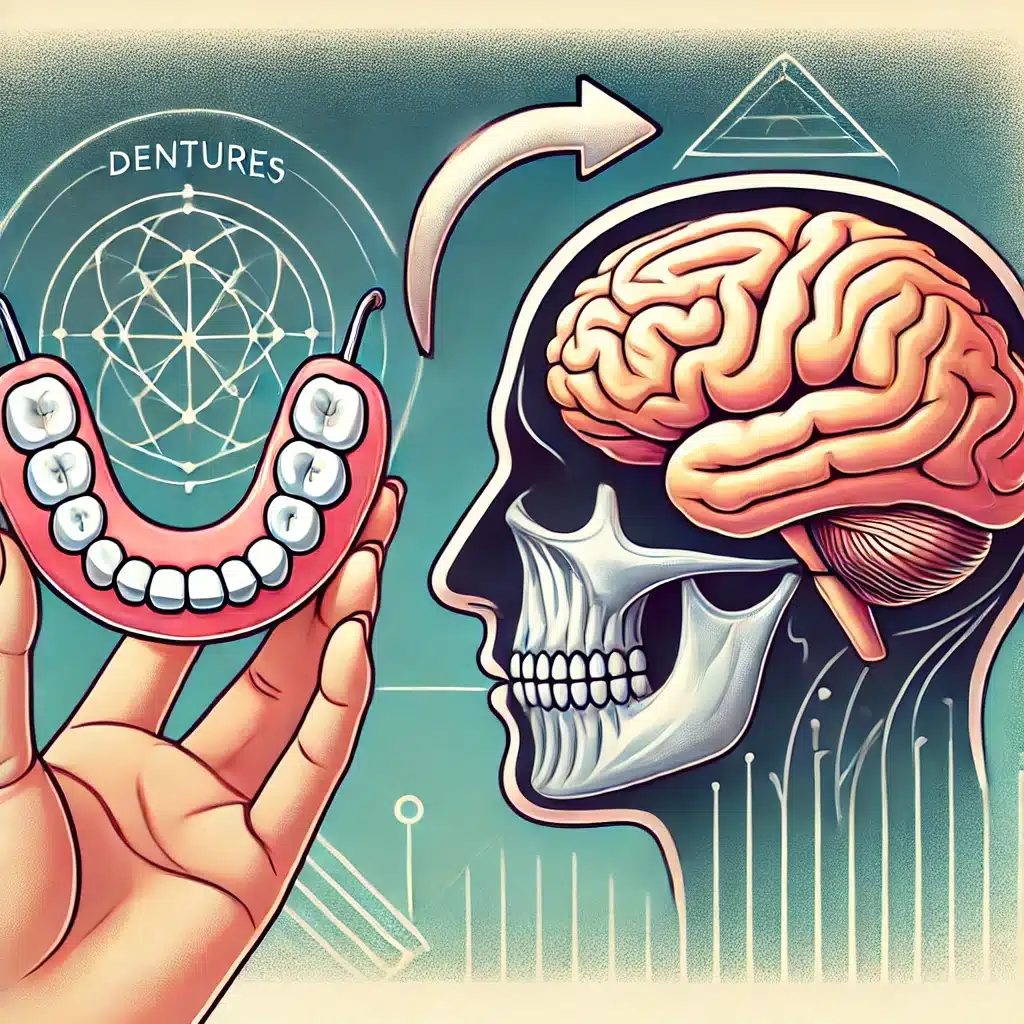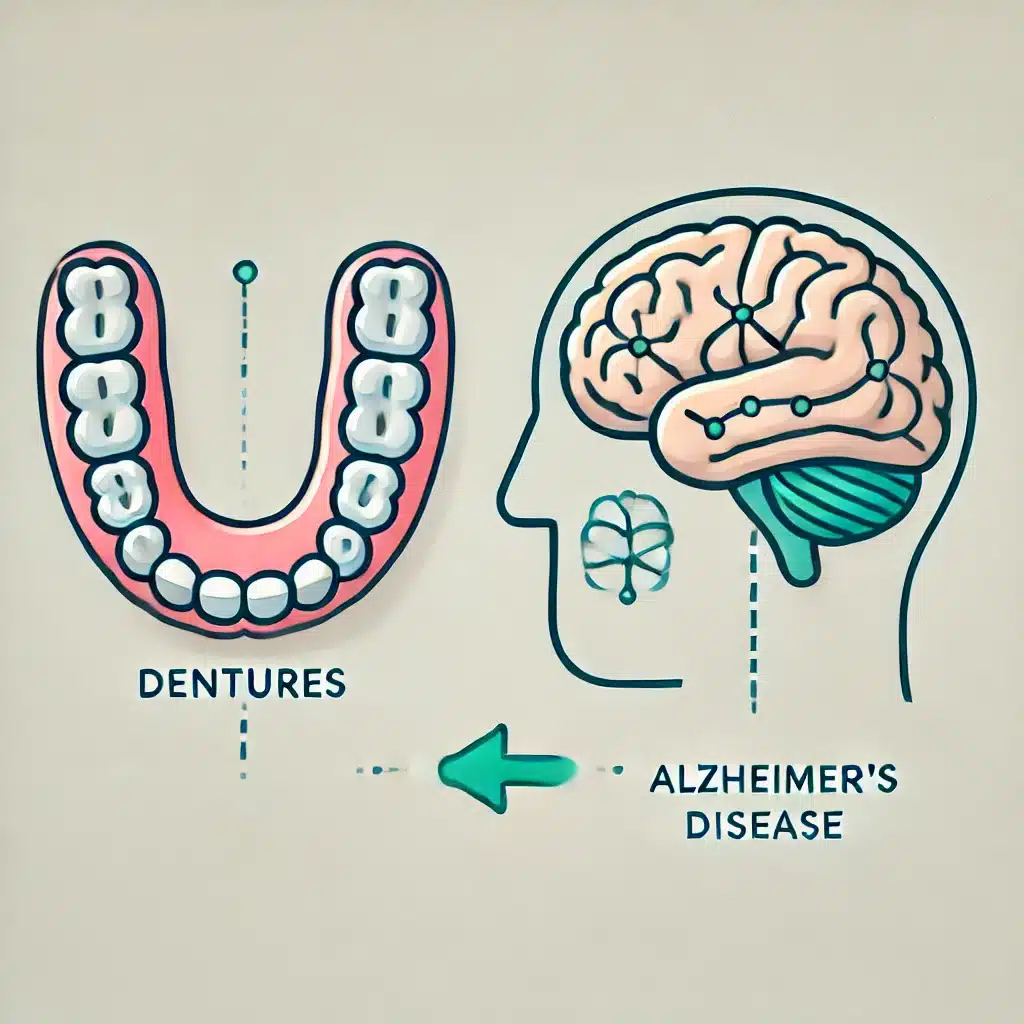Occlusion dysfunction (OD) is causally linked to an increased risk of Alzheimer’s disease (AD), while dentures restoration can mitigate this risk.
Highlights:
- Periodontal disease (PD) and Alzheimer’s do not have a direct causal relationship (P = 0.395).
- Loose teeth significantly increase the risk of AD progression (P = 0.017, OR = 187.3567).
- Dentures restoration is significantly associated with a reduced risk of AD (P = 0.015, OR = 0.0234).
- There was a strong causal relationship between occlusion dysfunction and Alzheimer’s disease.
- Occlusion function is identified as a potentially protective factor for maintaining neurological health.
Source: Frontiers in Aging Neuroscience (2024)
What is Occlusion Dysfunction?
Occlusion dysfunction (OD) refers to problems with the alignment and function of the teeth when the jaws are closed.
This can result from various factors such as missing teeth, misaligned bites, or severe periodontal disease (PD).
OD can lead to difficulties in chewing, increased tooth wear, and even jaw pain.
It affects how the teeth come together (occlude) and can disrupt the overall harmony of the dental structures, impacting the ability to chew and speak properly.
Study Overview: Causal Link Between Occlusion Dysfunction & Alzheimers Disease (2024)

The goal of this study was to evaluate the causal relationship between occlusion dysfunction (OD) and Alzheimer’s disease (AD) using Mendelian randomization (MR) analysis.
Sample
The study utilized genome-wide association study (GWAS) meta-analysis data from 3 major sources:
- FinnGen
- IEU Open GWAS
- UK Biobank (UKBB)
Methods
- Instrumental Variables: Genetic variants (SNPs) associated with periodontal disease (PD), loose teeth, and dentures restoration were used as instrumental variables.
- Mendelian Randomization Analysis: MR analysis was conducted using four methodologies: MR Egger, Weighted median, Inverse variance weighted (IVW), and Weighted mode. The primary reliance was on IVW analysis for its reliability and accuracy.
- Data Screening: SNPs were selected based on strong association with exposures (PD, loose teeth, dentures restoration) and were filtered to exclude confounding factors and palindromic SNPs.
- Sensitivity Analysis: Heterogeneity and pleiotropy were assessed using Cochrane Q test and MR Egger, respectively, to ensure the robustness of the results.
Limitations
- Self-Reported Data: AD data from the UK Biobank relied on self-reports, which may introduce biases despite being a reliable proxy for clinical diagnosis.
- Population Specificity: The study focused on a European population, which may limit the generalizability of the findings to other ethnic groups.
- Indirect Measures: The study used loose teeth as a proxy for OD and dentures restoration as a proxy for occlusion recovery, which may not capture all nuances of these conditions.
- Complex Etiology of AD: The multifactorial nature of AD means that other genetic and environmental factors not accounted for in this study could influence the results.
How Occlusion Dysfunction May Be Directly Linked to Alzheimer’s Disease

1. Sensory Input Reduction
Teeth and their surrounding structures are rich in sensory receptors.
Proper occlusion ensures adequate sensory input to the brain, which is essential for maintaining cognitive functions.
OD, such as loose or missing teeth, reduces this sensory input, potentially leading to neurodegeneration and cognitive decline.
2. Neurotransmitter Impact
OD can affect the production and release of neurotransmitters in the brain.
For instance, reduced sensory input from the teeth can impair the pathways responsible for neurotransmitter release, such as dopamine and acetylcholine, which are critical for memory and learning.
This disruption can contribute to the cognitive deficits seen in Alzheimer’s disease (AD).
3. Inflammation
Severe OD often results from chronic PD, a condition associated with persistent inflammation.
Inflammation from PD can spread to the brain, leading to neuroinflammation, which is a known factor in AD development.
The bacteria from periodontal infections can travel to the brain, exacerbate inflammation, and contribute to amyloid plaque formation, a hallmark of AD.
4. Brain Structure Changes
OD can lead to changes in brain structure.
Studies have shown that tooth loss and OD are associated with reduced brain volume in areas critical for memory and cognitive function, such as the hippocampus.
This atrophy can exacerbate the symptoms and progression of AD.
5. Chewing Function & Blood Flow
Chewing increases blood flow to the brain, which is crucial for maintaining brain health.
OD impairs chewing efficiency, leading to reduced blood flow and nutrient delivery to the brain.
This decrease in cerebral perfusion can contribute to the brain’s vulnerability to degenerative diseases like AD.
6. Neuroprotective Factors
Proper occlusion and effective chewing stimulate the release of neurotrophic factors such as brain-derived neurotrophic factor (BDNF), which supports neuron growth and survival.
OD can diminish these beneficial effects, increasing the risk of neurodegeneration.
Skepticism of Occlusion Dysfunction Causing Alzheimer’s Disease

Lack of Whole Genome Sequencing
The study relied on genome-wide association study (GWAS) data, which covers only a subset of the genome.
Whole genome sequencing, which examines the entire genetic code, might reveal additional genetic variants that influence both occlusion dysfunction (OD) and Alzheimer’s disease (AD).
The absence of this comprehensive data could mean important genetic factors are missed, potentially skewing the results.
Underlying Genes Linked to Certain Behaviors
Certain genetic variants might predispose individuals to behaviors that increase the risk for both OD and AD.
For example, genes influencing poor oral hygiene habits or dietary choices could lead to both dental issues and cognitive decline.
These behavioral links can confound the apparent causal relationship, as the behaviors, rather than the genetic variants themselves, might be driving the association.
Genes Increasing Risk for Both Conditions
Some genes might independently increase the risk for both OD and AD without one causing the other.
This phenomenon, known as pleiotropy, occurs when a single gene influences multiple traits.
If such pleiotropic genes are involved, they could create a false impression of a causal link between OD and AD.
For instance, genes affecting inflammatory responses could contribute to both periodontal disease (leading to OD) and neuroinflammation (a factor in AD).
Unaccounted Genetic & Environmental Factors
The development of AD is influenced by a complex interplay of genetic, environmental, and lifestyle factors.
If the study does not account for all these factors, the results might not reflect a true causal relationship.
Environmental factors like smoking, diet, and socioeconomic status, which are not fully captured in genetic data, could also affect both dental health and cognitive function.
Limitations of Mendelian Randomization (MR)
Mendelian randomization (MR) relies on certain assumptions, such as the absence of confounding variables and the relevance of instrumental variables.
If these assumptions are violated, the results might not accurately represent causality.
For example, if the selected genetic variants are not strictly related to the exposures being studied or if they influence the outcomes through pathways not accounted for, the MR analysis might yield misleading conclusions.
Conclusion: Occlusion Dysfunction & Alzheimer’s Disease Link
This study provides important insights into the potential causal relationships between occlusion dysfunction (OD) and Alzheimer’s disease (AD), highlighting that loose teeth significantly increase the risk of AD, while dentures restoration can reduce this risk.
However, the findings suggest that periodontal disease (PD) alone does not have a direct causal link to AD.
Despite the robust methodology, including Mendelian randomization analysis, the results should be interpreted with caution due to potential limitations such as incomplete genetic data, behavioral correlations, and the complexity of AD’s etiology.
Future research, incorporating whole genome sequencing and broader genetic and environmental considerations, is necessary to validate these results and fully understand the intricate connections between dental health and neurodegenerative diseases.
Maintaining good occlusion function and addressing dental issues might emerge as vital strategies for protecting neurological health and preventing AD.
References
- Study: Occlusion dysfunction and Alzheimer’s disease: Mendelian randomization study (2024)
- Authors: Qing Wang et al.







